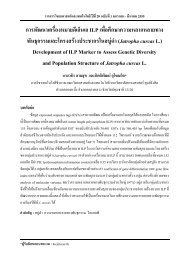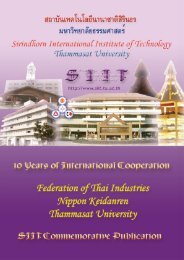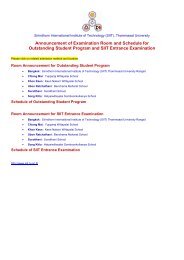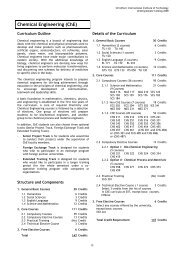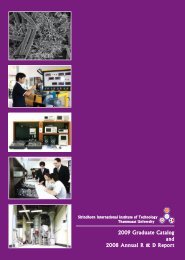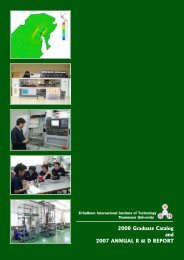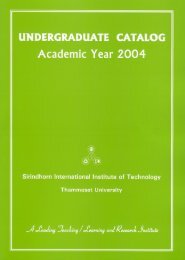2005 Graduate Catalog and 2004 Annual R & D Report - Sirindhorn ...
2005 Graduate Catalog and 2004 Annual R & D Report - Sirindhorn ...
2005 Graduate Catalog and 2004 Annual R & D Report - Sirindhorn ...
- No tags were found...
You also want an ePaper? Increase the reach of your titles
YUMPU automatically turns print PDFs into web optimized ePapers that Google loves.
<strong>2005</strong> <strong>Graduate</strong> <strong>Catalog</strong> <strong>and</strong> <strong>2004</strong> <strong>Annual</strong> R & D <strong>Report</strong><br />
<strong>Sirindhorn</strong> International Institute of Technology (SIIT)<br />
Dr. Chawalit Jeenanunta<br />
Lecturer (Joined SIIT in October <strong>2004</strong>)<br />
B.S. in Computer Science, University of Maryl<strong>and</strong>, USA<br />
B.S. in Mathematics, University of Maryl<strong>and</strong>, USA<br />
M.S. in Management Science, University of Maryl<strong>and</strong>, USA<br />
Ph.D. in Industrial <strong>and</strong> Systems Engineering, Virginia Polytechnic Institute <strong>and</strong> State University, USA<br />
Research Areas: Linear programming, Integer programming, Network optimization, Simulation.<br />
Research Interest:<br />
Large-Scale Simulation <strong>and</strong> Optimization<br />
Many problems in the real world are large <strong>and</strong><br />
complex. Researchers in this field are trying to<br />
improve the algorithm <strong>and</strong> utilize available<br />
computational technology such as parallelism or grid<br />
computing to solve such problems where their<br />
resulting models are also very large. This technology<br />
also enables researchers to have a detail model<br />
which is close to the real world problem. Some<br />
examples of these problems are transportation<br />
problem in the urban area (where there consist of<br />
millions of people driving on thous<strong>and</strong>s of streets),<br />
financial simulation, <strong>and</strong> bioinformatics.<br />
Dr. Cholwich Nattee<br />
Lecturer (Joined SIIT in May <strong>2005</strong>)<br />
B.Eng. in Computer Engineering, Chulalongkorn University, Thail<strong>and</strong><br />
M.Eng. in Computer Science, Tokyo Institute of Technology, Japan<br />
D.Eng. in Computer Science, Tokyo Institute of Technology, Japan<br />
Research Areas: Artificial intelligence, Machine learning, Knowledge discovery <strong>and</strong> Data mining, Artifcial<br />
Intelligence applications in distance learning <strong>and</strong> pattern recognition.<br />
Research Interest:<br />
Inductive Logic Programming for Structure-<br />
Activity Relationship Studies<br />
Nowadays, a vast amount of chemical compound<br />
structure information can be produced due to<br />
advances in High Throughput Screening technology<br />
that automates compound screening using the<br />
combination of robotics, image processing <strong>and</strong><br />
pattern recognition. From these data, knowledge<br />
describing compound activities <strong>and</strong> characteristics<br />
from their structures is essential, since it can be used<br />
for predicting characteristics of unknown compounds<br />
for developing new drugs. Machine learning <strong>and</strong> data<br />
mining techniques have been applied in order to<br />
automatically obtain models describing the relations<br />
between structure <strong>and</strong> activity. However, traditional<br />
data mining algorithms have limitations on knowledge<br />
representations. Thus, complicated structures of<br />
chemical compounds cannot be h<strong>and</strong>led efficiently.<br />
Extended from traditional machine learning<br />
techniques, Inductive Logic Programming (ILP)<br />
applies first-order logic for representing data. This<br />
allows complicated structures or relations among<br />
training examples to be denoted without losing any<br />
information. Moreover, learning results in the form of<br />
first-order rules, are comprehensible. The knowledge<br />
obtained can be easily explained to domain experts.<br />
Dr. Ekawit Nantajeewarawat<br />
Associate Professor<br />
B.Eng. in Computer Engineering, Chulalongkorn University, Thail<strong>and</strong><br />
M.Eng. & D.Eng. in Computer Science, Asian Institute of Technology (AIT), Thail<strong>and</strong><br />
Areas of Specialization: Knowledge representations, Computational logics, Computation theory, Programming<br />
paradigms, Object-oriented system analysis <strong>and</strong> design.<br />
Research Interests:<br />
Semantic Web<br />
Expectedly, Semantic Web technology will bring<br />
about large-scale heterogeneous Web knowledge<br />
bases with a qualitatively new level of service. The<br />
concept of ontology (domain theory) will play a key<br />
role as a formal, explicit specification of shared<br />
conceptualizations that describe the semantics of<br />
data on the Web. Grounded upon Description logics<br />
(DLs), the theory of XML declarative descriptions<br />
(XDD) <strong>and</strong> Resource Description Framework (RDF),<br />
formal ontology languages as well as meta-level<br />
representation of Web resources are investigated.<br />
The possibility of developing automated reasoning<br />
systems for Semantic Web is explored from both<br />
theoretical <strong>and</strong> practical viewpoints, e.g., a hybrid<br />
reasoning system comprising a DL-based reasoning<br />
component <strong>and</strong> a rule-based backward chaining<br />
component. Realization of the Semantic Web vision<br />
dem<strong>and</strong>s further research work on several other<br />
knowledge-representation-related issues.<br />
23




